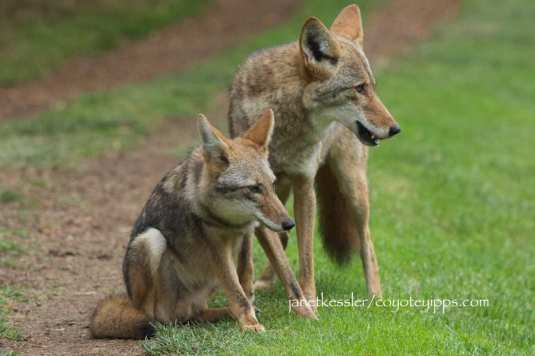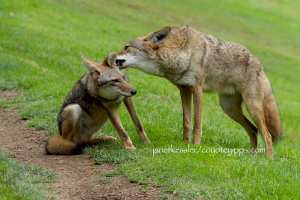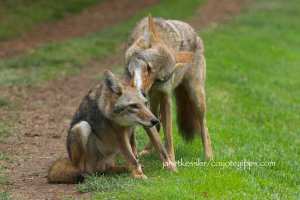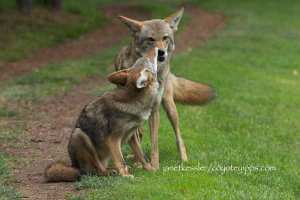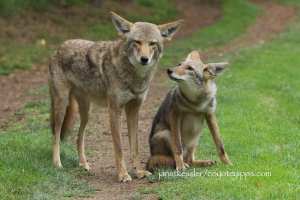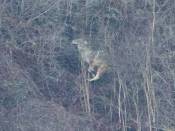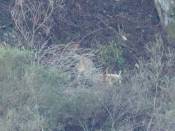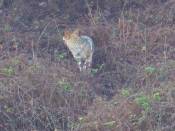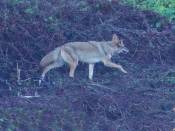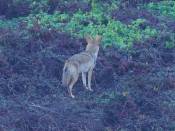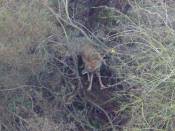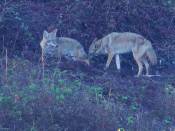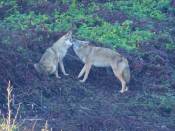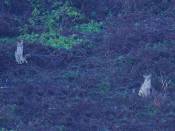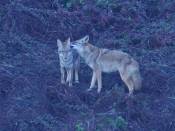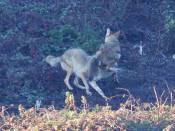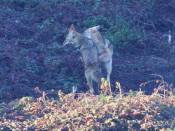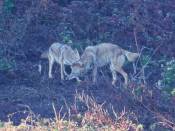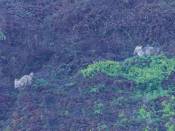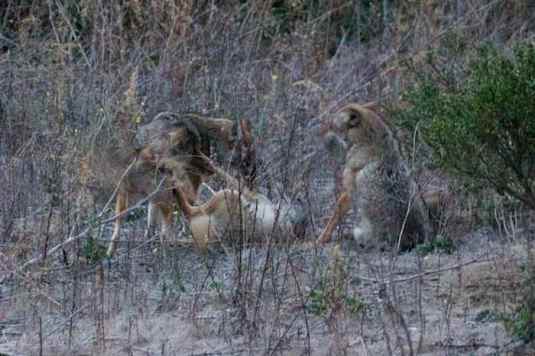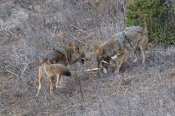
Hi Janet,
I wanted to share with you a student’s observations and leanings. Which lead to more questions.
Kinky Tail continues to raise her very active litter. There are 7 now..so either there was a miscount originally or 2 have disappeared. They think 2 pups have disappeared because there is a local golden eagle who for years has been seen with coyote pups, fox kits and feral cats. It seasonally comes to this area during lambing and calving times. It has been seen daily flying over den areas.
That well may have encouraged Kinky to move pups as well as..ticks. Locally we’ve seen plague level numbers of ticks. And Kinkys grooming times with pups seemed very long last week. Her last den area was absolutely infested with 3 species of ticks. Ugh.
Now however, Kinky moved pups to a rendezvous of log piles, poison oak bushes, and grazing cattle.
The student says she doesn’t believe the location was randomly picked.
The abundance of poison oak keeps people out except rarely riders of horse or quads passing thru. Ranch folk.
The grazed range grass is short and doesn’t hold high tick densities compared with long grasses or brush areas.
And finally, having an entire cow to scavenge 2 miles away after move means less animals near pups (scavengers galore) and Kinky doesn’t have to hunt the longer grass fields for voles. Which mean tick pick up. She has the cow or many dozens of caches. Also discovered was she visits an orchard and gleans old fallen Apple’s from last Fall.
This Student feels Kinky’s choice of den was premeditated and thought carefully out. It has minimal tick numbers. Humans rarely come and pass quickly. It’s open with vast vistas and hillsides yet has hiding places for pups. The Longhorns don’t encourage canine visitors. It’s close to dead cow but far enough pups don’t meet scavengers.
She also is study wild turkey brood site selections and says the studies lend to each other. Wild Turkey Hens need to sit on eggs around 28 days. The picked site is obviously paramount. A poorly picked site is disastrous. There are hens that pick poorly or lose patience or dedication and leave eggs too long as well. Then there are hens that cover eggs while minimally foraging for bugs and food and rush back fast. How a Hen Broods means Everything. And not all hens are good moms.
She says it’s same for Coyote. Some mothers are functional but rather minimal. Or make bad choices. Some..seem to be absolutely dedicated mothers. She feels most coyote are very dedicated Moms.
So how much is choice and thought when picking a site to hide and raise your kids? She feels Kinky Tail is neighborhood cognizant.
In her words “No wolf gang signs. No noisy dog parties. No bad nosy people. Riding thru people that she’s known since pup and plenty of longhorns and poison oak seem the latest mood and pic”
Kinky is doing well. She has 7 very active very fat pups. She’s busy busy busy. By day she stays at den. At night it’s cow scavenging, cow caches and long long drinks. And some nights old apples. She grooms her pups even as she comes home bedraggled. Growls briefly but playfully at Mate as he leaves for day shift.
Real Estate Realities are working out for Kinky.
Lou














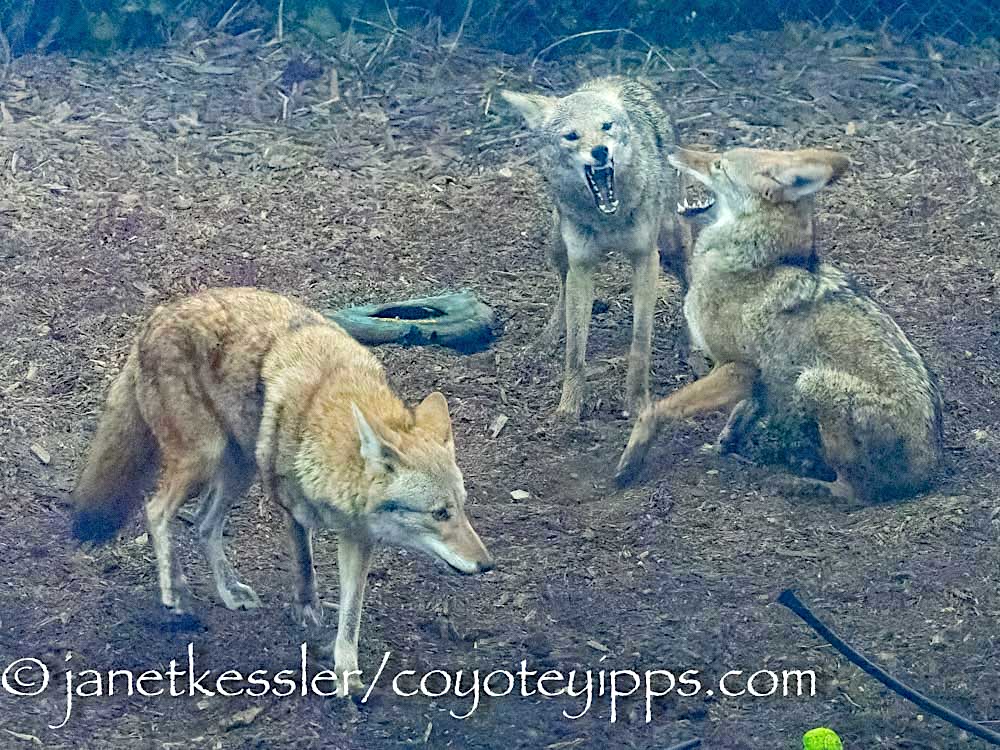
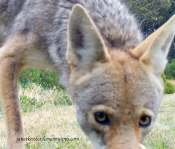
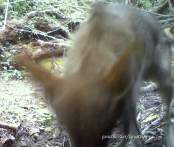
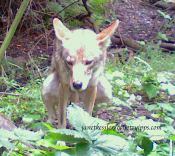
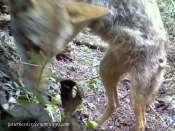

 Two years ago, this coyote pair raised pups here in one of SF’s smaller parks. The coyotes had been tamed by feeders who not only fed them, but befriended them to the degree that the coyotes would wait around at the park entrance for handouts, as close as 5 feet or even less from people and their mostly leashed dogs. But unleashed dogs went chasing after the coyotes on a regular basis, making the coyotes very uncomfortable. The pups of course were kept totally secret, but I suppose dogs and people came close enough, often enough, to the secret den so that Mom decided she didn’t want to repeat the stressful experience.
Two years ago, this coyote pair raised pups here in one of SF’s smaller parks. The coyotes had been tamed by feeders who not only fed them, but befriended them to the degree that the coyotes would wait around at the park entrance for handouts, as close as 5 feet or even less from people and their mostly leashed dogs. But unleashed dogs went chasing after the coyotes on a regular basis, making the coyotes very uncomfortable. The pups of course were kept totally secret, but I suppose dogs and people came close enough, often enough, to the secret den so that Mom decided she didn’t want to repeat the stressful experience.






